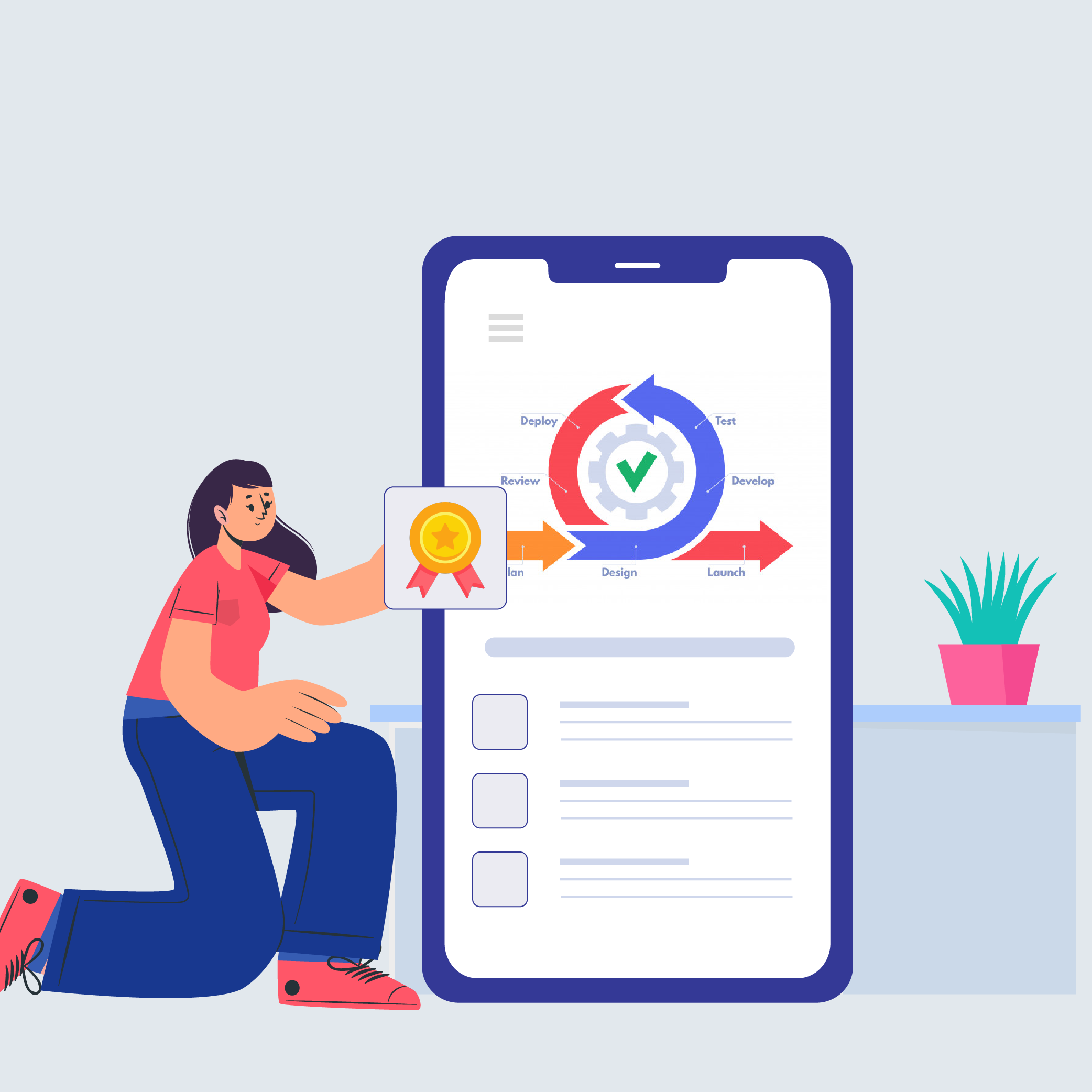Reasons why we Trust Agile for our Mobile App Development Process
Agile Mobile Application Development has emerged as a concept that ensures not just a quick delivery of projects but also the one that guarantees app responsiveness and overall business growth and agility.
It was after three app projects, developed and deployed using the Waterfall model, we realized that we were not just slow but also the team lacked clarity, which showed in the apps. It was a loss for both us and the brands we were developing apps for, as the resources were getting freezed for more time than they should along with the missing sense of a clear process.
Let us look into the concept in more detail. Highlighting the meaning of the methodology and the associated benefits and ultimately the approach we follow for developing apps using agile methodology.
Let’s start –
What is Agile Mobile App Development About?
The Agile Methodology is a term used for an incremental and iterative app development approach, which consists of breaking down the complete app development process cycle in various different tasks. The whole array of segregated processes are further categorized into number of sub-tasks, every one of which performs as separate modules among the app development team. Next, each of the module is handed to a dedicated cross-functioning group of specialists who then work on every module as an independent mini-project.
Using this agile methodology for mobile application development enables multiple teams to develop different parts of the apps simultaneously. The whole project becomes a combination of various small modules. Agile software development method not just lowers the associated risk, but even provides developers with full freedom and flexibility for developing a superior-quality app, which quickly adjusts to alterations post-release.
Now that you know what Agile Development is, let us look at why agile is best for app development, reasons to use agile methodology, and why app development companies like us, swear by it.
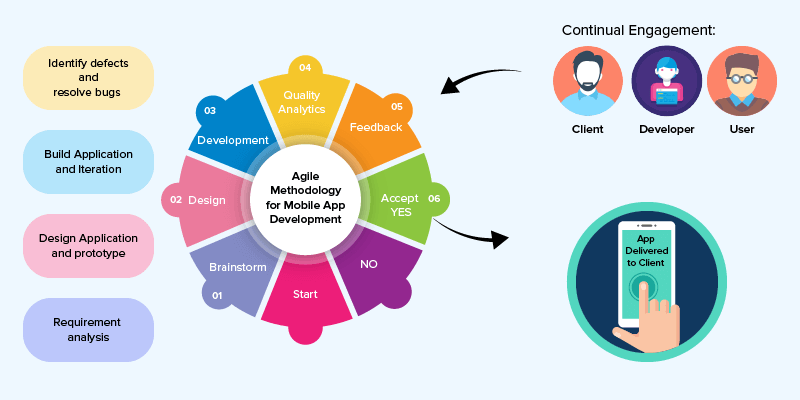
Why use Agile App Development Process?
Agile for mobile app development helps agile software developers to efficiently come up agile development methodology and project management system that is foolproof in many ways. It certainly assists agile software development company and development teams to overcome some critical development issues like varying demands of various classes of users, which in turn hinders seamless development across multiple running platforms.
Agile is the go-to framework for helping app startups and development agencies maintain a focus on delivering a quality application ー rapidly and productively. Agile maximizes value throughout the development process and significantly decreases the overall risk of any given project.
1. Quality Product
It was expected to test software before the launch, however with agile, testing is integrated at every phase of development to guarantee a quality end result. This type of continuous testing of every single module provides space for changes and reduces the risk of encountering a bug during quality testing of the complete project. It also helps mobile app developers to inspect app elements at every phase of the development process and make alterations as per the requirement, eventually helping in providing high quality of services.
2. Customization
While opting for agile development best practices, developers get the chance to customize the whole app development process according to their preference and work upon user- driven solutions. Thus, customization is another reason behind why use agile methodology for creating mobile applications.
In a situation where developers are on the hunt for various techniques for creating and launching a mobile application while integrating the recent technologies into the development process, agile methodology approach keeps you covered.
3. Swift Return on Investment
Backed by iterative nature, app features are developed and deployed speedily in an agile development process, leading to rapid application development. Contrary to the earlier used waterfall development methodology where you had to sit till the completion of an app project to even look at return on investment value, agile methodology allows you to drive ROIs in advance. In agile app development process, the stakeholder plays a very crucial role and stays in direct conversation with the project’s scrum master to help prioritize the main features and then show an aligned development process.
4. Reduced Risks
The previously used waterfall app development system came with high chances of failures, which varied from budget shortage, timeline extensions, scope creep, not being able to have the priority features, even by the time of project completion.
While Agile, on the other side, employs parallel test model to allow you to line up the different mobile application development problems while developing other features, simultaneously. The transparency that the process comes with the scrum process of agile app development process enables you to view and remove the issues of even the later-stages from their roots, in the beginning stages itself.
5. Helps to Move with Business Agility
Rapid variations in the smartphone user movements hints towards the need of brands to promote superior level of business agility by using agile process method. Agile method enables you to adjust to the varying business needs or user trends in spite of what stage of app development you are in, without any further amount of investment. Agile method gives you the freedom to not be confined to work around a pre set feature list as a part of mobile app solution. This enhanced business dexterity gives the application any shape you are seeking, thus giving you an unprecedented edge over the competitors.
6. Enhanced productivity
The sprint-based workflow of agile methodology lowers the scope of daily detailed discussions and concentrates on the delivery of list of the high-valued app features in every sprint. Using collaboration, mobile app developers’ team works on goals with accountability, which helps in meeting all the commitments in fixed time. The distinct set of work, which are decided for specific time frames allow scrum master to measure the real-time work status and can handle the teams, likewise.
7. Develop superior quality mobile app development solutions
Quality undoubtedly continues to be the main concerns in an app world. Because of the collateral testing model used in the agile mobile app development process, it gets easier for mobile app developers to inspect an app project in the real-time and then undergo the necessary quality based improvements hand-by-hand. With respect to this, when there are variations in both – the mobile application needs or in the quality standards which have to be maintained, the project managers can get them incorporated and solved, instantly.
{Read more: Best 5 Diagrams Used To Explain Product Management Concepts}
8. Placing Responsiveness in the Technology
By combining agile sprints with the app’s software update method, the enhancements along with the needed new features, based on customer feedback, can be made instantly, lowering the development timeline.
Agile mobile development process introduces a data backed consistent app updation process that makes sure that even with the app updates, the data is spatially harmonious with old data.
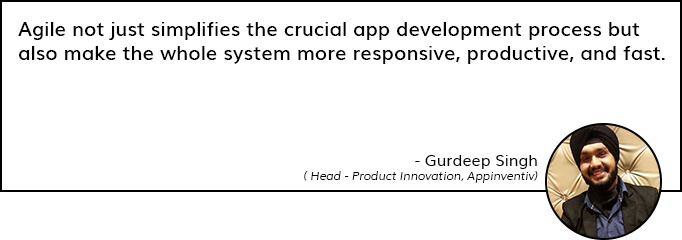
Now, as promised earlier, we will now get into the basics of how we employ Agile Development in the apps that we develop.
Agile development process in itself comes in different types. While we focus on Scrum to a large extent, there are around five other types of Agile App Development methodologies, which we use in combination, which varies from app to app.
Let us look at each of them, to give you a better understanding of the types there are and what you should expect to achieve from each.
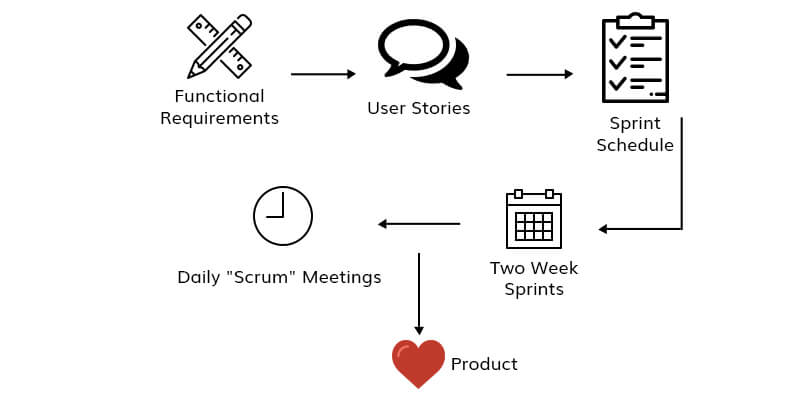
Types of Agile App Development Methods
1. Adaptive Software Development
This method is used in software projects, which have shifting requirements and strictly fall in the category of short span app projects. The methodology takes help of processes like collaboration, speculation, and learning to achieve this.
2. Crystal Methods
These are the methodologies that are used to help develop app by concentrating on app properties such as reflective improvement,frequent delivery, focus, close communication, easy access to expert users, and personal safety, taking help of configuration management, automated tests, and recurrent integrations. The process works best when developing apps that are related to people, community, interaction, talents, skills, and communication.
3. Dynamic Systems Development Method (DSDM)
It is an iterative agile development method which ensures that every step is completed just enough to be able to move on to the next stage. It helps in delivering working systems in short span of time. This process aids in aiding regularly changing scenario since the next level of process can be easily put to work by not affecting the process of delivery in whatever way.
DSDM makes use of tools,knowledge, and techniques and helps with the delivery of new systems in the expected period of time.
4. Feature Driven Development
This is the agile methodology for app development process, which is also model driven. At the start of the app project, the developers design a model, which specifies various app features and their iterations.
5. Lean Development
It is one of the most used agile methodologies, in fact the one we swear upon, which is implemented for the development of mobile apps. This principle aims at managing the risks and turn them into opportunities. This, then offers a competitive advantage to a business over its counterparts.
6. Scrum
Scrum is another agile software development process that implements the flexible process control for complex software projects. It likewise makes use of iterative and growing practices. In light of the theory that we can’t characterize the last prerequisites of the project, initially, the information is acquired over the due process from the mistakes made over the long run. It solely focuses around checking the progress of the project and resolving the challenges when it is encountered in the frequent gatherings. It gives the benefits of agile methodology that it assists to take action as and when the requirement changes.
7. Extreme Programming
Here, the focus is entirely on the app project instead of the documentation, since it follows principles of design and simple code. Which, in turn, makes it easy for the developers who join late, to understand the process.
The method is based on twelve practices and four groups. The four groups include – feedback,collaboration, respect, and revision. This requires the direct participation of all the involved parties including our customers.
The twelve practices are collective code ownership, coding standards, system metaphor, simple design, pair programming, test driven development, planning game, refactoring, the whole team, continuous integration, short releases, and a sustainable pace.
Now that you know the types of Agile Development Process, let me take you through the Approach we follow while developing and deploying Mobile Apps on the basis of the methodology.
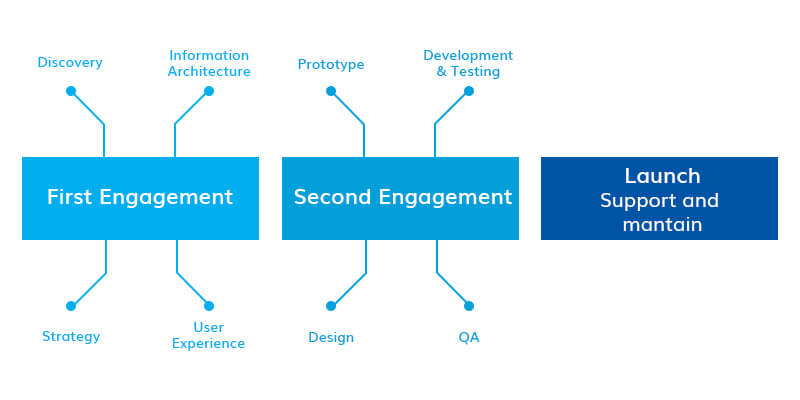
Appinventiv Approach to Developing Apps Using Agile Development Process
When we start an app development project here at Appinventiv, we segregate the functional requirements in user stories, which becomes the basis of our app development process.
We mostly work in the structure of two-weeks sprint set, and restate continuously till we gain milestones in the app. This includes apps that come with a very high number number of brand requirements
The method has helped us work on projects with as much as 3,500 different development needs, by breaking down the requirement in small, manageable processes.
We divide our Approach into processes that include –
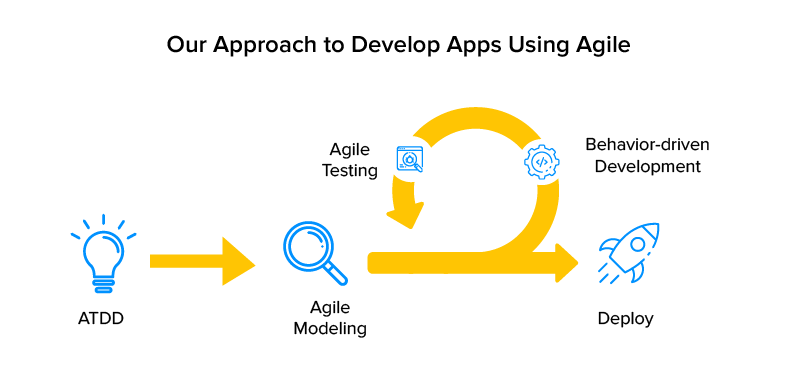
– Acceptance Test-Driven Development (ATDD)
Connecting you with the developers, designers, and the testers, which helps you communicate the specific requirements even before the actual implementation.
– Agile Modeling
We document the principles and values for applying in mobile app development work, which ease the implementation of agile development methods like the extreme programming, Scrum, and the Rational Unified Process.
– Agile Testing
Making mobile app testing a crucial part of mobile app development process, we ensure that the bugs and errors are next to nothing. Lead by our team of testers, Agile method help keeps every involved party from the UX-UI designers to the app developers in the circle.
– Backlogs
Every one of our POCs know their to-do lists and the what’s left lists. This helps in achieving client’s expectations through the incremental and iterative mobile app development process.
– Behavior-Driven Development
Every app functionality is validated in planned way to not miss test cases or criterias defining them. It also includes the prime causes and their relevant fixes.
Need help with streamlining your app development process? Contact our team of Mobile App Developers, today.

strategies your digital product..
